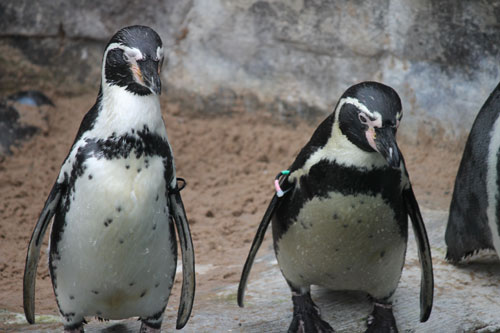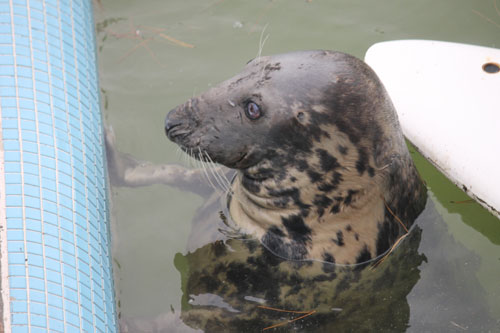After a long, long lie in, we eventually left the house and headed down to the Cornish Seal Sanctuary. It had taken a bit of working out as to where we were going to go today because the weather was not particularly promising. The river was a bit misty, the rain spent a fair bit of the morning wisping by and the wind was changeable. It wasn’t, as I said, very promising.
Mirinda then announced that we were off to the Cornish Seal Sanctuary (Bob thought she’d said we were going to visit the Seal Factory) so we programmed Linda and hit the road. Following the factory, we were going to try for a garden.
We managed to arrive at the seal factory in time to see the otter feeding. Actually, that’s not entirely true. I missed the otter feeding because I was having fun with the Humboldt penguins.
I then made my way down to Otter Creek. Otter Creek is a long way away from the rest of the Sanctuary. I think the seals didn’t want the otters for close neighbours. They do smell a bit, after all. If you walk far enough, passing the numerous fact signs, you will eventually come to Otter Creek.
If, like me, you time it badly, you will hear the last of the spiel before the assistant turns the microphone off. Not that I missed everything. The food isn’t just thrown at them all in one go. Oh no. The assistants hide bits and pieces in various articles like logs and bushes, trees and rocks. This means the otters get to wander around, looking all over the place for food.
Except for carrot. They really dislike carrots. In fact the enclosure had bits of carrot scattered all over the place where the otters had left them. Apparently they leave them till last, when everything else even remotely edible has been eaten. Bit like Carmen except she never gets desperate enough to eat them.
According to Bob and Mirinda, the otters are given, among other things, day old chips or chicks or something very similar in sound. I still have no idea what this is. I have discovered (from one of the wooden otter-info signs), that they eat rats, so day old chicks shouldn’t be a big problem. However, they rather love fish as well so I’d think chips would be perfect.
After the feeding of the otters, we headed back to the seals and penguins and other water dwellers.
The Cornish Seal Sanctuary has been in existence since 1958, rescuing seals, originally, in St Agnes, Cornwall. Since then, they have rescued more than 2,000 seals and brought succour to many other animals. A lot of the seals in the sanctuary were victims of bad storms rather than human activity. It seems brain damage and blindness are pretty rife in seal populations.
But let’s not concentrate on the nastier bits of seal conservation…once they have entered the sanctuary, they are cared for and strengthened before they are released back into the wild from whence they came. They are generally released in a quiet location in the early hours of the morning so that they can get used to their new surroundings without being disturbed by humans and/or dogs.
The plan was then to visit a garden. Well, the weather determined otherwise so we headed off to Truro instead. After a lovely lunch at a very difficult to find eating place, we popped into the cathedral.
It looks old and magnificent but it’s not really THAT old. Truro cathedral was designed by John Loughborough Pearson (he won a competition), the same man who designed many other cathedrals including the one in Brisbane. But, before Truro could have a cathedral, it needed a bishop (apparently). There hadn’t been a bishop in Cornwall since about 1050 – the CofE didn’t think they needed one, I guess.
So, Edward White Benson (later the Archbishop of Canterbury) was given the job of getting Truro a big church. It was decided to use St Mary’s parish church which was nicely squeezed in between various buildings in the centre of town. Some of the projected plans incorporated St Mary’s into the design and, in fact, Pearson managed to keep the steeple while pulling everything else down.
Possibly one of the most impressive things about Truro cathedral is the reredos screen. It was carved by Nathaniel Hitch, an amazing young man who, at the age of 12, created a small model of the vestry of Ware church. He became a sculptor journeyman and would wander around Britain carving architectural bits and bobs for churches. He was a bit of a favourite with Pearson and worked on a lot of his projects.
And so, finally, Truro Cathedral (to the blessed virgin Mary) was completed in 1903. It looks Gothic but it’s actually Victorian.
¬¬¬¬¬¬¬¬¬
Dinner was spent in the impossibly perfect Pandora Inn, bits of which date back to the 15th century. Ignoring the sloping floors, the thick walls, the lovely little snugs, the excellent beer and food, I just have to mention the collection of boat paraphernalia dotted around it. It even included a figurehead from HMS Pandora, proudly suspended above the stairs leading up to the restaurant, clutching her box (lid firmly closed), face set with grim determination.
Bob and Mirinda decided to have the half pint of prawns for entree. This was mainly because Mirinda wanted to show Bob why it’s imperative that I have prawns whenever we visit Australia. When they arrived, Bob was stunned.
In Australia, half a pint of prawns would amount to about four. Here, in Britain, half a pint of prawns is an entire school. British prawns are also quite difficult to peel because they are so small. When the finished flesh is about the size of the nail on your little finger, you have to be careful how you remove its bits. I’m sure a few were lost.
I had scallops and langoustines because I know how tasteless and unremarkable British prawns are. Our main courses were far more satisfying. Bob had fish pie, I had hake wrapped in bacon and Mirinda had the ribs of an entire pig.
The combination of the food and the atmosphere was splendid – we had a view looking out over the river and along the pier directly outside the pub…which we took a stroll along after our meal.
The pier stretches well out into the river (which is a very good thing given that low tide leaves most of it on dry land) with tables and benches sat on it for, we figured, the multitudes of summer patrons. With an almost full moon casting a beautiful black and white glow over everything, it look fabulously romantic. I tried for a photograph. This is the best I could do.






